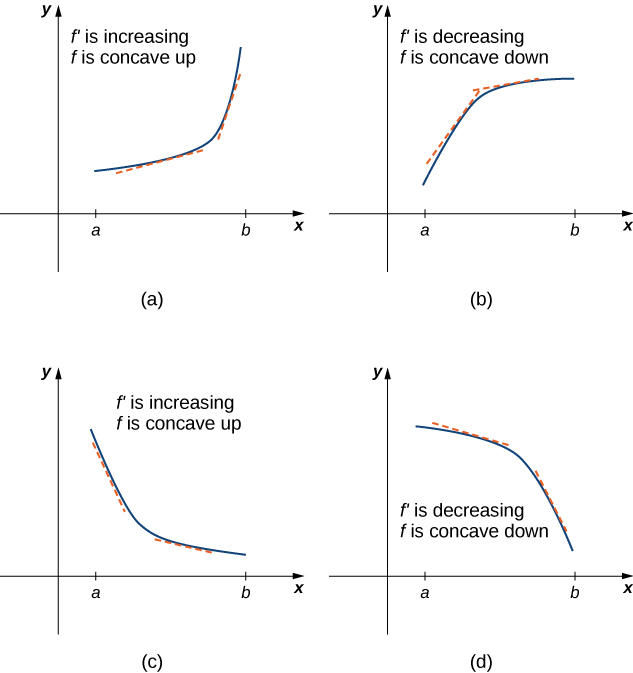Concavity and Points of Inflection
We now know how to determine where a function is increasing or decreasing. However, there is another issue to consider regarding the shape of the graph of a function. If the graph curves, does it curve upward or curve downward? This notion is called the concavity of the function.
Figure 5(a) shows a function [latex]f[/latex] with a graph that curves upward. As [latex]x[/latex] increases, the slope of the tangent line increases. Thus, since the derivative increases as [latex]x[/latex] increases, [latex]f^{\prime}[/latex] is an increasing function. We say this function [latex]f[/latex] is concave up.
Figure 5(b) shows a function [latex]f[/latex] that curves downward. As [latex]x[/latex] increases, the slope of the tangent line decreases. Since the derivative decreases as [latex]x[/latex] increases, [latex]f^{\prime}[/latex] is a decreasing function. We say this function [latex]f[/latex] is concave down.

concave up and concave down
Let [latex]f[/latex] be a function that is differentiable over an open interval [latex]I[/latex].
- If [latex]f^{\prime}[/latex] is increasing over [latex]I[/latex], we say [latex]f[/latex] is concave up over [latex]I[/latex].
- If [latex]f^{\prime}[/latex] is decreasing over [latex]I[/latex], we say [latex]f[/latex] is concave down over [latex]I[/latex].
In general, without having the graph of a function [latex]f[/latex], how can we determine its concavity?
By definition, a function [latex]f[/latex] is concave up if [latex]f^{\prime}[/latex] is increasing. From Corollary 3, we know that if [latex]f^{\prime}[/latex] is a differentiable function, then [latex]f^{\prime}[/latex] is increasing if its derivative [latex]f^{\prime \prime}(x)>0[/latex]. Therefore, a function [latex]f[/latex] that is twice differentiable is concave up when [latex]f^{\prime \prime}(x)>0[/latex].
Similarly, a function [latex]f[/latex] is concave down if [latex]f^{\prime}[/latex] is decreasing. We know that a differentiable function [latex]f^{\prime}[/latex] is decreasing if its derivative [latex]f^{\prime \prime}(x)<0[/latex]. Therefore, a twice-differentiable function [latex]f[/latex] is concave down when [latex]f^{\prime \prime}(x)<0[/latex].
Applying this logic is known as the concavity test.
test for concavity
Let [latex]f[/latex] be a function that is twice differentiable over an interval [latex]I[/latex].
- If [latex]f^{\prime \prime}(x)>0[/latex] for all [latex]x \in I[/latex], then [latex]f[/latex] is concave up over [latex]I[/latex].
- If [latex]f^{\prime \prime}(x)<0[/latex] for all [latex]x \in I[/latex], then [latex]f[/latex] is concave down over [latex]I[/latex].
We conclude that we can determine the concavity of a function [latex]f[/latex] by looking at the second derivative of [latex]f[/latex]. In addition, we observe that a function [latex]f[/latex] can switch concavity (Figure 6). However, a continuous function can switch concavity only at a point [latex]x[/latex] if [latex]f^{\prime \prime}(x)=0[/latex] or [latex]f^{\prime \prime}(x)[/latex] is undefined.
Consequently, to determine the intervals where a function [latex]f[/latex] is concave up and concave down, we look for those values of [latex]x[/latex] where [latex]f^{\prime \prime}(x)=0[/latex] or [latex]f^{\prime \prime}(x)[/latex] is undefined. When we have determined these points, we divide the domain of [latex]f[/latex] into smaller intervals and determine the sign of [latex]f^{\prime \prime}[/latex] over each of these smaller intervals.
If [latex]f^{\prime \prime}[/latex] changes sign as we pass through a point [latex]x[/latex], then [latex]f[/latex] changes concavity. It is important to remember that a function [latex]f[/latex] may not change concavity at a point [latex]x[/latex] even if [latex]f^{\prime \prime}(x)=0[/latex] or [latex]f^{\prime \prime}(x)[/latex] is undefined. If, however, [latex]f[/latex] does change concavity at a point [latex]a[/latex] and [latex]f[/latex] is continuous at [latex]a[/latex], we say the point [latex](a,f(a))[/latex] is an inflection point of [latex]f[/latex].
inflection point
If [latex]f[/latex] is continuous at [latex]a[/latex] and [latex]f[/latex] changes concavity at [latex]a[/latex], the point [latex](a,f(a))[/latex] is an inflection point of [latex]f[/latex].
For the function [latex]f(x)=x^3-6x^2+9x+30[/latex], determine all intervals where [latex]f[/latex] is concave up and all intervals where [latex]f[/latex] is concave down. List all inflection points for [latex]f[/latex]. Use a graphing utility to confirm your results.
The table and figure below summarize how the first and second derivatives of a function [latex]f(x)[/latex] inform the characteristics of its graph.
| Sign of [latex]f^{\prime}[/latex] | Sign of [latex]f^{\prime \prime}[/latex] | Is [latex]f[/latex] increasing or decreasing? | Concavity |
|---|---|---|---|
| Positive | Positive | Increasing | Concave up |
| Positive | Negative | Increasing | Concave down |
| Negative | Positive | Decreasing | Concave up |
| Negative | Negative | Decreasing | Concave down |
